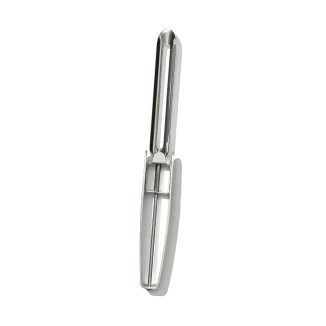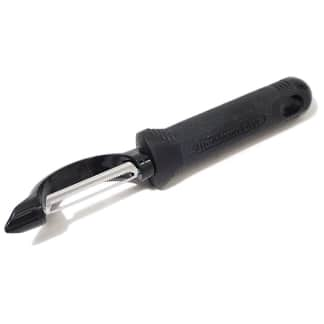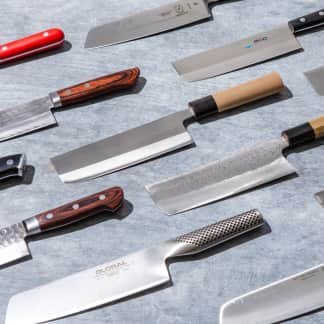A great peeler makes short work of prepping vegetables and fruit. The best are light and comfortable, with a sharp, maneuverable blade that peels neatly without waste and keeps its edge. There are two main types: Y-shaped and straight; we chose favorites of each. The Kuhn Rikon Original Swiss Peeler, our longtime Y-shaped winner, is our top choice, with its smoothly gliding, wickedly sharp carbon-steel blade. If you prefer straight peelers, we suggest the OXO Good Grips Swivel Peeler, with its sharp stainless-steel blade.
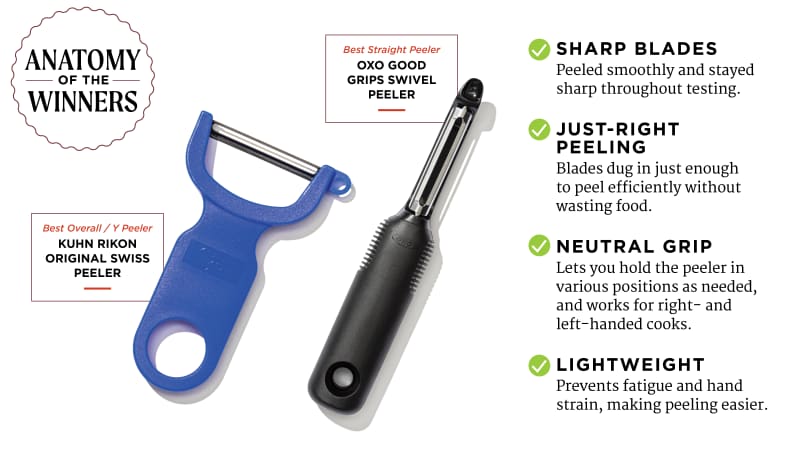
We use vegetable/fruit peelers to prep a variety of produce, from carrots and potatoes to tough squash, tender ginger, and leathery lemon peel—and even for shaving Parmesan flakes or making chocolate curls. Bad peelers abound, though, making these jobs tiresome and even sometimes dangerous.
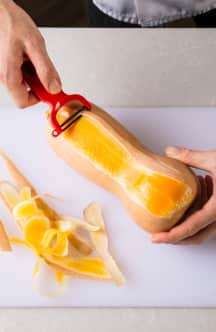


In the test kitchen we use peelers for more than vegetables such as butternut squash, left. We also use them to make Parmesan flakes, center, and to create decorative chocolate curls for baked goods, right.
A good peeler should be fast and smooth, shaving off just enough skin to avoid the need for repeat trips over the same section but not so much that the blade digs deeply into the flesh and wastes food. Whatever the task, the peeler should handle bumps and curves with ease and without clogging or losing its edge. And when the work is done, your hand shouldn’t feel the worse for wear.
We rounded up more than a dozen peelers in two main styles—Y-shaped and straight—plus a few innovative models, and put them to the test.
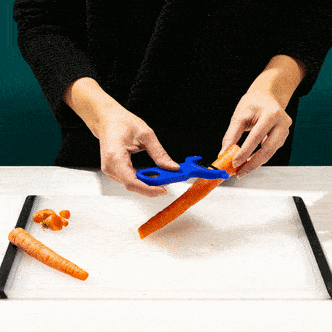

We like both Y peelers, left, and straight peelers, right, and found well-designed models that met our criteria for recommendation. We slightly prefer a Y peeler because its open Y shape gives us an unobstructed view—and better control—of the peeling action.
What to Look For
- A Style That Works for You: Whether you prefer a Y-shaped or straight peeler is personal. The overall shape of the peeler is the biggest difference. Straight peelers are the earliest form of vegetable peeler; they’re shaped like the paring knives that they were based on, with the blade extending straight out from the handle. Y peelers are, well, Y-shaped, with the blade suspended between the tips of the Y. They resemble razors. The next biggest difference comes down to the way you hold them: You grasp a straight peeler by its handle, like a knife. Y peelers are usually held between the thumb and forefinger. You can use both styles of peeler in either direction, flicking it away from you or pulling it toward you along the surface of food. On both, the peeler’s dual blade operates the same way, with the first half traveling over the food, guiding the angle of the second, which actually cuts in and does the peeling. On many peelers both blades are equally sharp, so you can reverse direction as needed. Why do we prefer a Y peeler? The open Y shape gives us an unobstructed view—and better control—of the peeling action, so we know exactly what is happening at all times. Typically, the thick head of a straight peeler set low over the blade blocks our view. A well-designed Y-shaped peeler’s head can be slim and more nimble in getting around curves and crannies. While our overall favorite is a Y peeler—don’t knock it till you’ve tried it!—use the shape that feels comfortable to you. We chose a winner in each style; they share attributes we value in any well-designed peeler.
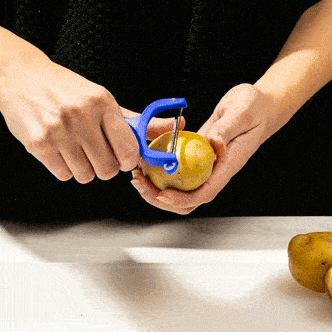
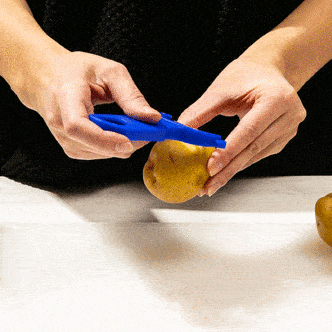
Depending on the shape of the particular food and your comfort, you can flick away or pull toward yourself as you peel produce such as this potato.
- Light Weight: Heavy designs may feel more “substantial,” giving the impression that they’re higher-quality tools, but your hands will be much more tired after using a heavy peeler. Our favorite weighs just ½ ounce; the heaviest weighs more than four times as much—and we noticed.
- Ergonomic Design: Produce comes in many shapes and textures, so we often need to change our grip on any peeler. Our favorites let us hold them several different ways to get the job done; this is called “affordance.” They also comfortably fit a variety of hands and were acceptable for both right-handed and left-handed users.
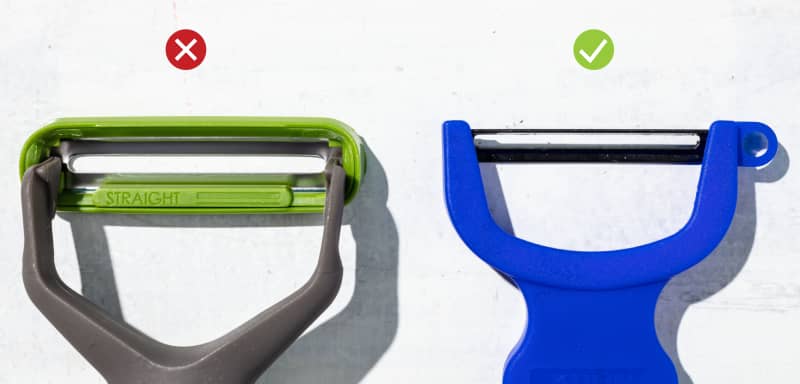
- Sharp Blade in a Maneuverable Head: Sharp blades are essential, but having a slim, narrow head (the part holding the blade) that can slip into small spaces and swivel to navigate produce’s curves and crannies is equally important.
- Good Visibility: We like being able to see the action while peeling. Some designs blocked our view.
- Designs That Contributed to Faster, Smoother Peeling: We timed peeling three medium carrots. The fastest took just 37 seconds; the slowest took 1 minute. The time difference is not huge, but it adds up while preparing a meal. Designs that contributed to smoother peeling, with fewer jams, made our work more efficient. These included sharper blades that glided over produce and that were set at an angle to peel just deeply enough (more on this below) and sufficient space (without obstacles) between blade and head so that peels kept moving out and away as we worked.


Our top-rated peeler, left, slid just under the surface to remove the right amount of peel. It didn’t waste food or make us travel over the same section of food more than once. But peelers that dug too deep, right, wasted good food. These too-thick cuts also were disappointing when we wanted perfect citrus peels without pith for cocktails, and gave us slabs of chocolate instead of spiraling into elegant curls.
- Just-Right Peeling: Some of the peelers removed big thick strips, others wispy, insignificant strips; the best pulled away substantial strips without going too deep. We examined the difference in the space between the blades and the angles and found two peelers can look pretty much the same and peel to totally different thicknesses. Measuring peels is the only way to really quantify it. We measured three of the most typical-looking peels from carrots and potatoes and averaged the three measurements to get a representative number. Our top-rated models all removed strips with an average thickness—not too thin, not too thick, just right.
- Durable Edge: Toward the end of testing, some blades began to drag or even got stuck. Our favorites simply kept their cutting edge sharp for longer.
- No Crevices That Trap Food: One peeler trapped bits of carrot around its head during our first test—and hung onto those scraps, despite scrubbing, soaking, picking with a sharp tool, and dishwashing three times. This is unsanitary. Most peelers were touted as dishwasher-safe and seemed fine after repeated cleaning by hand and machine. (Those with carbon-steel blades must be hand-washed and dried.) Bear in mind: The dishwasher is convenient but will shorten the life of your peeler. Harsh detergent, being wet for hours during washing cycles, and the potential to be knocked against other items in the machine will dull the peeler’s edge. We recommend hand-washing all bladed kitchen tools and drying them promptly.
Nice to Have
- Potato-Eye Removers: Little loops or scoops that protrude from peelers (near their blades) are designed for removing eyes on potatoes and blemishes from other produce. Even testers who said they’d never used the eye remover on their peeler enjoyed this feature. It let us scoop out blemishes and resume peeling in seconds. Not every model had one and not all were well designed to take out the smallest possible spot.

What to Avoid
- Heavy Peelers: Weighty peelers may feel substantial but quickly make peeling a tiring chore.
- Dull Blades: Dragging a peeler that struggles is miserable and slightly dangerous too. The worst models “chunked in,” as one tester put it, getting stuck and then suddenly unjamming. Or they never engaged with the peel in the first place and skidded dangerously.
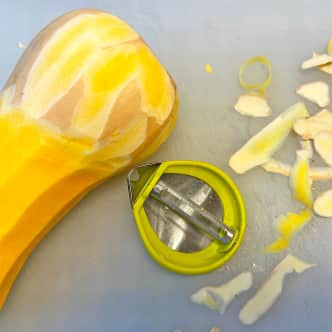

One innovative model that you wear like a ring, at left, was frustrating to use—we couldn’t see what we were doing. (Its blade also dulled by the end of testing.) Most Y peelers (like the one at right) made it easy to monitor progress.
- Poor Visibility: One innovative model that you wear like a ring and another shaped like a rubber stamp were frustrating to use—we couldn’t see what we were doing. Straight peelers with thick bridges over the backs of blades also blocked our view. Y peelers (or most of them) made it easier to monitor progress.
Minor Flaws
- Blunt or Upturned Potato-Eye Removers: Blunt eye removers took unsightly bites. One straight peeler’s upward-pointed scoop at the tip was dangerous; it slashed the hand of one tester trying to remove the eye from a potato. On straight peelers, seek out models with scoops that point down toward the blade.

- Serrated Blades: One model was named a “universal” peeler, but its serrated blade peeled too deeply and left grooves on the surface of foods, which testers disliked. Serrated peelers are designed to remove the skin of very soft fruits and vegetables, such as ripe peaches, plums, and tomatoes, where the ridged cutting edge helps the blade bite in just below the skin while not damaging the tender interior. We have a winning serrated peeler, but we don’t prefer this style as an all-purpose peeler.
Other Considerations
- Carbon-Steel vs. Stainless Blades: If you dislike traces of rust or patina and can’t clean and dry the peeler after use, carbon-steel blades are not for you; choose stainless steel. Note: Rust isn’t dangerous, and it’s easily scrubbed off the blade. An occasional wipe with oil helps prevent rusting. In our testing, a few stainless-steel blades dulled, but models with carbon-steel blades stayed sharp.
The Tests
- Peel three medium carrots, timing the process and measuring average peel thickness
- Peel round Yukon Gold potatoes
- Peel lumpy celery root
- Peel tough butternut squash
- Remove a long, oval strip of lemon peel with as little pith as possible (as for cocktail garnish)
- Peel small, lumpy ginger roots
- Have several extra testers of varied handedness, skill, height, and strength use peelers and give feedback
- Hand-wash after each test and wash dishwasher-safe models three times in dishwasher
- Examine condition of peelers at conclusion of testing
How We Rated
- Performance: We considered peelers’ effectiveness while peeling a variety of produce, as well as how thickly or thinly they removed skin from produce to minimize waste.
- Ease of Use: We assessed whether peelers were comfortable and intuitive and whether they glided smoothly or jammed.
- Cleanup/Durability: We evaluated how easy it was to keep peelers clean and in good operating condition.

















